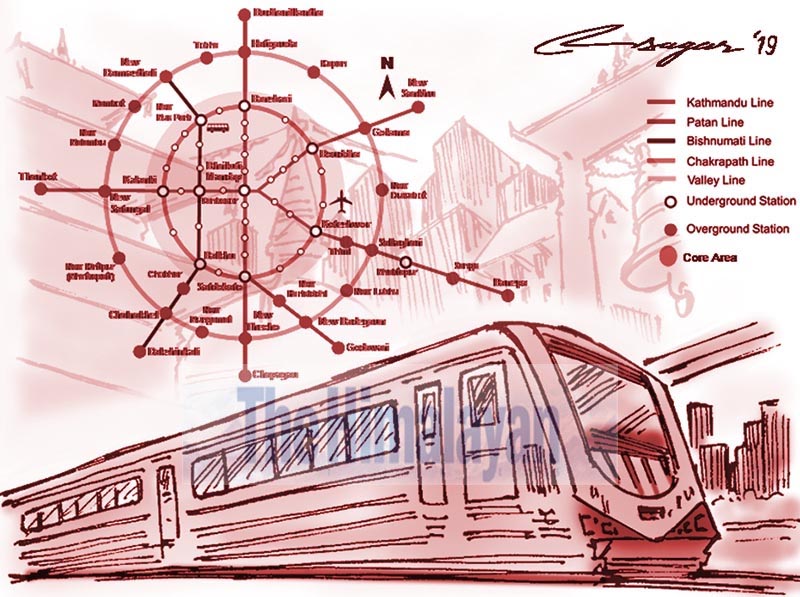Integrated metro rail: Way to ease congestion
Kathmandu will continue to grow. Therefore, the implementation of fragmented metro solutions promoted by the local authorities and government bodies will not solve Kathmandu’s transport problem
Modern Kathmandu has evolved haphazardly without adequate urban infrastructure and planning. In particular, there is no option currently for the population to shift to rail-based transportation. As a result, public spaces are limited, and narrow roads are barely coping with the traffic demand.
Life is a daily struggle in the capital for commuters because there is no reliable public transport system. The existing transport network of the valley is fragmented and ‘connectivity’ of the old and new settlements in the Kathmandu Valley barely exists. As a result, the number of private vehicles such as cars and motorbikes is increasing exponentially.
Nowadays the average speed of vehicles in the core urban area during the peak hour is only around 7 kmph. The valley is in desperate need of a modern urban railway network that could carry thousands of passengers every hour in each direction and operate without any interaction with the street vehicles. Such a rail network would also facilitate a comprehensive urban design and exploit the potential of each town or municipality. The new mode of transport is central to regeneration of the whole valley.
When planning an urban rail network for the valley, concepts such as ‘Crossrail in Kathmandu’ and ‘Orbital rail in Kathmandu’ are useful. The first concept comprises the establishment of railway routes crossing the city, which can rapidly connect the suburban areas. For ‘Crossrail of Kathmandu’, two lines are proposed, namely Kathmandu and Patan lines. Kathmandu line runs east to west whilst the Patan line runs north to south of the valley. Kathmandu line and the Patan line are about 54 km and 34 km long respectively.
The second concept is to connect the urban or sub-urban areas by orbital lines without a need to pass through the core part of the city. The Chakrapath line and Valley line are proposed as orbital lines. The Chakrapath line is about 30.5 km long and the Valley line (outer line) is about 53.5 km. The Bishnumati line – 20.5 km - will further strengthen the urban rail network. Development of these five routes could truly integrate the 18 municipalities of the valley.
Development of such a master plan is, however, seriously lacking in the current exercise carried out by various government authorities. Instead, the government authorities are acting independently. Such as the Investment Board is conducting a DPR of the Dhulikhel-Nagdunga route; the Department of Railways (DORW) is conducting a DPR of Satdobato-Ratna Park-Narayan Gopal Chowk and also a DPR for another Satdobato-Kalanki-Narayan Gopal Chowk-Budhanilkantha route. A DPR of a monorail by Kathmandu Metropolitan Corporation is also in the news. These show a complete lack of coordination, planning and integrated vision of metro development in the valley.
Kathmandu will continue to grow. Therefore, the implementation of fragmented metro solutions promoted by the local authorities and government bodies will not solve Kathmandu’s transport problem. They will rather create more congestion in the city and obstructions for future coherent development.
Monorail or tram is only effective where passenger flow is limited and a supplementary transport mode would enhance the traffic flow. Cable metro could be relevant to a hilly topography serving towns and villages on the outskirts of the valley. Considering the sheer volume of passengers flowing around the capital, a metro rail system with a capacity ranging from 25,000 to 60,000 per hour per direction is essential to manage the present and future transport.
The transport infrastructure development should not be limited to the core part of the city. The government should develop a visionary integrated transport plan for the whole valley and the surrounding hills with metro rail as the main transport system and other forms/ modes of transport such as bus, cable metro as feeders to the main metro system. This will enhance efficiency of the transport network and avoid duplication and destruction of heritage and traditional settlements.
Kathmandu Metro rail development should not be isolated from the upcoming national rail network as well. It is essential to connect the metro system with these upcoming regional/ national railway network for inter-hub (travel between hubs) connection. That will bring greater passenger flow and higher fare revenue. Metro development should also foresee possible international routes, which could pass through the valley for connection to India and China. Only with such trans-country connection, or potential connection for the future, would the grand success of the metro scheme materialise.
Thus, a visionary integrated transport plan for the whole valley and the surrounding areas with metro rail as the main transport system and other modes of transport as feeders is essential. Connection of Kathmandu Metro Rail with upcoming regional, national and possible international rail development is also essential for the ultimate success of the metro development and thus economic prosperity of the capital city. Establishment of a powerful government body, such as a Kathmandu Metro Rail Development Authority (KMRDA), is necessary for effective coordination and implementation of various routes under study.
Amatya is principal ground engineering consultant in the UK






